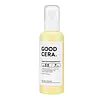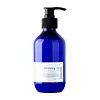What's inside
What's inside
 Key Ingredients
Key Ingredients

 Benefits
Benefits

 Concerns
Concerns

 Ingredients Side-by-side
Ingredients Side-by-side

Water
Skin ConditioningHydrogenated Polyisobutene
EmollientCyclopentasiloxane
EmollientBetaine
HumectantGlycerin
HumectantButylene Glycol
HumectantNeopentyl Glycol Dicaprate
Emollient1,2-Hexanediol
Skin ConditioningC14-22 Alcohols
Emulsion StabilisingHydrogenated Lecithin
EmulsifyingDimethicone
EmollientCetearyl Alcohol
EmollientCaprylic/Capric Triglyceride
MaskingC12-20 Alkyl Glucoside
EmulsifyingAmmonium Acryloyldimethyltaurate/Vp Copolymer
Batyl Alcohol
EmollientStearic Acid
CleansingCamellia Oleifera Seed Oil
Skin ConditioningLecithin
EmollientTocopheryl Acetate
AntioxidantEthylhexylglycerin
Skin ConditioningXanthan Gum
EmulsifyingDisodium EDTA
Glyceryl Stearate
EmollientSodium Hyaluronate
HumectantPolyquaternium-51
Skin ConditioningNiacinamide
SmoothingGlycerylamidoethyl Methacrylate/Stearyl Methacrylate Copolymer
HumectantEthylhexyl Isononanoate
EmollientDipropylene Glycol
HumectantAlteromonas Ferment Extract
Skin ConditioningPropylene Glycol
HumectantPhytosteryl/Isostearyl/Cetyl/Stearyl/Behenyl Dimer Dilinoleate
Skin ConditioningBacillus Ferment
Skin ConditioningLavandula Angustifolia Oil
MaskingCeramide NP
Skin ConditioningHydroxypropyl Bispalmitamide Mea
EmollientGlycine Soja Sterols
EmollientYeast Extract
Skin ConditioningMeadowfoam Estolide
Skin ConditioningGlycoproteins
Skin ConditioningGlyceryl Polymethacrylate
Cymbopogon Citratus Leaf Oil
MaskingCitrus Grandis Fruit/Peel Water
HumectantAleuritic Acid
Skin ConditioningTheobroma Cacao Seed Extract
AntioxidantPelargonium Graveolens Oil
MaskingCetearyl Glucoside
EmulsifyingHydrogenated Polydecene
EmollientCitrus Aurantium Dulcis Peel Oil
MaskingSantalum Album Oil
MaskingPogostemon Cablin Leaf Oil
MaskingChamomilla Recutita Flower Oil
MaskingGlycosphingolipids
EmollientGlyceryl Citrate/Lactate/Linoleate/Oleate
EmulsifyingCeteareth-20
CleansingButyrospermum Parkii Butter
Skin ConditioningCeramide AP
Skin ConditioningCeramide EOP
Skin ConditioningWater, Hydrogenated Polyisobutene, Cyclopentasiloxane, Betaine, Glycerin, Butylene Glycol, Neopentyl Glycol Dicaprate, 1,2-Hexanediol, C14-22 Alcohols, Hydrogenated Lecithin, Dimethicone, Cetearyl Alcohol, Caprylic/Capric Triglyceride, C12-20 Alkyl Glucoside, Ammonium Acryloyldimethyltaurate/Vp Copolymer, Batyl Alcohol, Stearic Acid, Camellia Oleifera Seed Oil, Lecithin, Tocopheryl Acetate, Ethylhexylglycerin, Xanthan Gum, Disodium EDTA, Glyceryl Stearate, Sodium Hyaluronate, Polyquaternium-51, Niacinamide, Glycerylamidoethyl Methacrylate/Stearyl Methacrylate Copolymer, Ethylhexyl Isononanoate, Dipropylene Glycol, Alteromonas Ferment Extract, Propylene Glycol, Phytosteryl/Isostearyl/Cetyl/Stearyl/Behenyl Dimer Dilinoleate, Bacillus Ferment, Lavandula Angustifolia Oil, Ceramide NP, Hydroxypropyl Bispalmitamide Mea, Glycine Soja Sterols, Yeast Extract, Meadowfoam Estolide, Glycoproteins, Glyceryl Polymethacrylate, Cymbopogon Citratus Leaf Oil, Citrus Grandis Fruit/Peel Water, Aleuritic Acid, Theobroma Cacao Seed Extract, Pelargonium Graveolens Oil, Cetearyl Glucoside, Hydrogenated Polydecene, Citrus Aurantium Dulcis Peel Oil, Santalum Album Oil, Pogostemon Cablin Leaf Oil, Chamomilla Recutita Flower Oil, Glycosphingolipids, Glyceryl Citrate/Lactate/Linoleate/Oleate, Ceteareth-20, Butyrospermum Parkii Butter, Ceramide AP, Ceramide EOP
Water
Skin ConditioningGlycerin
HumectantUrea
BufferingCaprylic/Capric Triglyceride
MaskingStearyl Alcohol
EmollientCetyl Alcohol
Emollient1,2-Hexanediol
Skin ConditioningLonicera Japonica Flower Extract
Skin ConditioningPolyglyceryl-3 Methylglucose Distearate
EmulsifyingCetyl Ethylhexanoate
EmollientSorbitan Olivate
EmulsifyingGlyceryl Caprylate
EmollientPalmitic Acid
EmollientButylene Glycol
HumectantOzokerite
Emulsion StabilisingHydrogenated Vegetable Oil
EmollientStearic Acid
CleansingArginine
MaskingCarbomer
Emulsion StabilisingBeeswax
Emulsion StabilisingStearyl Stearate
EmollientHydrogenated Palm Acid
Myristyl Alcohol
EmollientLauryl Alcohol
EmollientMyristic Acid
CleansingLauric Acid
CleansingOleic Acid
EmollientEthylhexylglycerin
Skin ConditioningWater, Glycerin, Urea, Caprylic/Capric Triglyceride, Stearyl Alcohol, Cetyl Alcohol, 1,2-Hexanediol, Lonicera Japonica Flower Extract, Polyglyceryl-3 Methylglucose Distearate, Cetyl Ethylhexanoate, Sorbitan Olivate, Glyceryl Caprylate, Palmitic Acid, Butylene Glycol, Ozokerite, Hydrogenated Vegetable Oil, Stearic Acid, Arginine, Carbomer, Beeswax, Stearyl Stearate, Hydrogenated Palm Acid, Myristyl Alcohol, Lauryl Alcohol, Myristic Acid, Lauric Acid, Oleic Acid, Ethylhexylglycerin
Ingredients Explained
These ingredients are found in both products.
Ingredients higher up in an ingredient list are typically present in a larger amount.
1,2-Hexanediol is a synthetic liquid and another multi-functional powerhouse.
It is a:
- Humectant, drawing moisture into the skin
- Emollient, helping to soften skin
- Solvent, dispersing and stabilizing formulas
- Preservative booster, enhancing the antimicrobial activity of other preservatives
Butylene Glycol (or BG) is used within cosmetic products for a few different reasons:
Overall, Butylene Glycol is a safe and well-rounded ingredient that works well with other ingredients.
Though this ingredient works well with most skin types, some people with sensitive skin may experience a reaction such as allergic rashes, closed comedones, or itchiness.
Learn more about Butylene GlycolThis ingredient is an emollient, solvent, and texture enhancer. It is considered a skin-softener by helping the skin prevent moisture loss.
It helps thicken a product's formula and makes it easier to spread by dissolving clumping compounds.
Caprylic Triglyceride is made by combining glycerin with coconut oil, forming a clear liquid.
While there is an assumption Caprylic Triglyceride can clog pores due to it being derived from coconut oil, there is no research supporting this.
Learn more about Caprylic/Capric TriglycerideEthylhexylglycerin (we can't pronounce this either) is commonly used as a preservative and skin softener. It is derived from glyceryl.
You might see Ethylhexylglycerin often paired with other preservatives such as phenoxyethanol. Ethylhexylglycerin has been found to increase the effectiveness of these other preservatives.
Glycerin is already naturally found in your skin. It helps moisturize and protect your skin.
A study from 2016 found glycerin to be more effective as a humectant than AHAs and hyaluronic acid.
As a humectant, it helps the skin stay hydrated by pulling moisture to your skin. The low molecular weight of glycerin allows it to pull moisture into the deeper layers of your skin.
Hydrated skin improves your skin barrier; Your skin barrier helps protect against irritants and bacteria.
Glycerin has also been found to have antimicrobial and antiviral properties. Due to these properties, glycerin is often used in wound and burn treatments.
In cosmetics, glycerin is usually derived from plants such as soybean or palm. However, it can also be sourced from animals, such as tallow or animal fat.
This ingredient is organic, colorless, odorless, and non-toxic.
Glycerin is the name for this ingredient in American English. British English uses Glycerol/Glycerine.
Learn more about GlycerinStearic Acid is a fatty acid. It is an emollient, emulsifier, and texture enhancer.
As an emollient, stearic acid helps soften skin. It aids the skin's protective barrier by preventing water loss. It also provides a gentle cleansing effect without stripping away natural oils.
Stearic acid may also be used to enhance the texture of products. It can add volume and stabilize ingredients such as water and oil. This can help water and oil ingredients from separating.
Sources of stearic acid include animal or vegetable fats/oils such as coconut or shea. It can be naturally found in butter, cocoa butter, shea butter, vegetable fats, and animal tallow.
This ingredient may not be Malassezia folliculitis, or fungal-acne safe.
Learn more about Stearic AcidWater. It's the most common cosmetic ingredient of all. You'll usually see it at the top of ingredient lists, meaning that it makes up the largest part of the product.
So why is it so popular? Water most often acts as a solvent - this means that it helps dissolve other ingredients into the formulation.
You'll also recognize water as that liquid we all need to stay alive. If you see this, drink a glass of water. Stay hydrated!
Learn more about Water